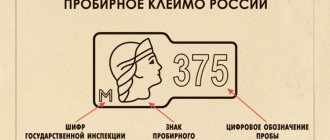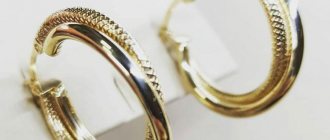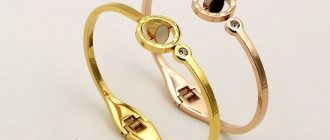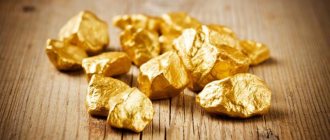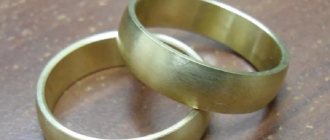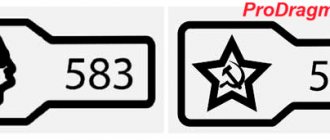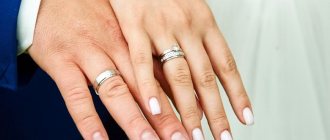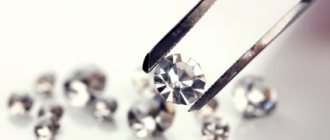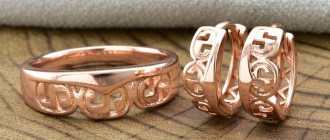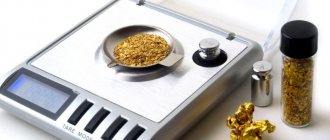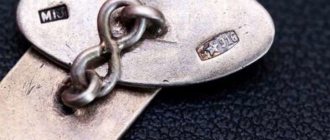Unfortunately, even when buying gold in expensive stores with a good reputation, it is not possible to be 100% sure of its quality. There are many ways to test gold that can be done at home, but they are all unreliable and cannot be completely relied on. In a workshop setting, a gold reagent is used for testing.
Testing gold with a reagent
Stages of gold testing
Each product made of precious metal that is imported or sold through retail chains is subject to testing. The process is controlled by the government Assay Office. The jewelry is stamped with a mark that indicates the percentage of gold in the alloy. For example, 750 standard indicates that the noble metal contains 75%, 585 standard indicates 58.5%, etc. For convenience and systematization of branding, state sample systems have been developed, the most famous of which are metric and carat. The latter is used in Western countries.
The process of testing gold products consists of several stages.
- Visual inspection of the product. Particular attention is paid to the quality of the mark, its clarity, evenness of lines and legibility. On fakes, the sample has an uneven structure, numbers and letters are difficult to see. In addition, careful examination of the symbols will help identify gilding or jewelry. A specialist, upon visual inspection of the jewelry, can easily determine its quality and whether it belongs to a particular group of alloys.
- Cleaning the product. With the permission of the owner, part of the surface of the jewelry is cleaned before testing. This is necessary to confirm that the item being tested is truly gold and not gilded. During work, needle files, finely cut files and a tool for precise processing of the surfaces of metal products - a scraper - are used. The procedure is performed from the inside of the product, as carefully as possible and away from the assay mark.
- Application of the reagent. After preliminary determination of the sample, a reagent is applied to the stripped part of the decoration in a vertical position. The drop should not spread. An important point is the exposure time of the assay material on the surface. It varies depending on the type of reagent and sample. Acids on metal with marks 375, 500 and 585 are kept for 5-10 s, and with mark 750 - 20 s. Gold chloride should be on the surface for 7-12 s, potassium iodide - no more than 5 s. Failure to comply with the time intervals will lead to distortion of the characteristic chemical reaction. At the end of the procedure, a drop of the reagent is removed with a napkin or piece of calico.
Applying a reagent to gold
Testing jewelry is accompanied by characteristic reactions, according to which the alloy sample is determined.
The procedure is relevant for products on which the mark has worn off and is difficult to see.
How gold is counterfeited
There are two types of fake gold. The first type is alloys for jewelry, which have a coating of expensive metal on the surface. There is a more complex type of counterfeit, which is more difficult to recognize. The lock is made of gold, and the product itself is made of another metal. The stamp is placed on the clasp; the rest of the product is unsampled.
“Gypsy gold” (samovar gold, randol) - yellow copper or brass, coated with a thin layer of real gold, contains a small amount of beryllium. It dissolves well in almost all acids. Such products shine brightly without losing color over time.
“Gypsy gold” is used in industry (aviation, automotive). Randoli is used to make jewelry, watches, decorative items, coins and other items. Randole corresponds to approximately 375 fineness of the precious metal.
Often gold is counterfeited with another metal - tungsten. It has a similar density - 19.3 g/cm3. A blank is created from tungsten, which in further production is coated with noble, expensive metal or gold plating. Such deception can be revealed by drilling a small hole in it and through it you can look at the internal contents of the object and understand what you are dealing with.
Red brass. This is a well-known and popular metal used by unscrupulous jewelers. Visually identifying a fake in this case is extremely difficult even for experienced specialists and appraisers. This alloy consists of copper (90%) and zinc (10%). Other metals are added to the alloy to determine its properties, including color.
Types of reagents and their effect on gold alloys
Testing of gold jewelry is carried out using several types of reagents. Each of them is used for a specific alloy and has a characteristic effect on it.
Chlorine gold
Gold chloride is a reagent used for testing jewelry without specifying samples. Thus, you can find out whether the alloy being tested contains precious metal and in what quantity.
Gold chloride is suitable for detecting counterfeits. With its help you can distinguish real gold from gilding and costume jewelry. In addition, the reagent is applicable for white precious metal 500, 583/585.
When choosing a chemical for testing jewelry, you need to know that it only works on alloys with a gold content of up to 60%.
Acidic reagents
Acid compounds for testing precious metals are a mixture of nitric and hydrochloric acids in various proportions. Distilled water is added to them. For example:
- nitric acid density 1.5;
- hydrochloric acid, density 1.20;
- distilled water.
The amount of reagents directly depends on the samples of the alloys being studied.
The effect of acid reagents on gold is of two types. On some products they leave a light stain, on others they do not have any reaction. The chemical element does not affect high-grade alloys or leaves dark marks on them.
Each acid reagent corresponds to a specific sample for analysis: 375, 750, etc. The lower the gold content in the alloy, the more pronounced the color of the reagent stain.
Acidic reagents for gold determination
When testing gold alloys of 375, 500, 750 standard, acid-containing preparations leave a transparent drop on the cleaned area without any trace. In rare cases, a subtle light shadow appears.
If the reagent is dropped onto a product made of base metal, a certain reaction will begin on its surface, followed by bubbling and the appearance of a greenish precipitate. A specific unpleasant odor will also appear.
Potassium iodide solution
The product is used to test alloys with a high content of precious metals. This chemical is used to detect counterfeit metals that are resistant to other reagents. The reagent with a solution of potassium iodide does not work on alloys whose fineness starts from 900. On a product with a mark of 800 and on jewelry with high chemical resistance, a black or green spot will form with possible subsequent bubbling.
The principle of alloying gold with metals
More suitable for processing is a material that is characterized by ductility, low melting point, and strength. The choice of ligatures and their combination with each other allows you to find the best option, taking into account the given characteristics. When one of the additives is introduced, the composition of the material changes. To correct the result obtained, another additive is introduced. For this reason, the metal may contain 1-2 alloys or more.
Note: The homoizing treatment procedure is carried out in order to increase the degree of homogeneity of the precious metal, the desired result is achieved by reheating to a temperature of +700°C, further holding the alloy improves the structure.
Method of using reagents
Reagents for gold can quite accurately determine their sample; they are convenient to use on a large scale, and not at home. Their use for testing begins with inspection of the product. Sometimes one glance at a sample is enough to identify a fake. The mark may contain asymmetrical symbols, curved shapes and images. The next step is to determine whether the alloy belongs to the group of low-grade or high-grade gold.
The surface of the product in a certain place is cleaned. This helps to find out if there is another metal underneath the gold layer or if it is a single alloy. The further procedure depends on the type of reagent chosen.
Gold chloride does not act equally on different compositions. To check the purity, the reagent is applied to the surface of the jewelry. Alloys from 585 to 999 samples will not react in any way to the chemical compound. On products that contain half of the total mass of precious metal, gold chloride will leave a dark stain. If the material has a negligible yellow metal content, less than 50%, the reagent will cause a reaction in the form of severe darkening and the appearance of a precipitate. The lower the sample, the richer the color and stronger the sediment.
When using gold chloride, you need to be very careful and observe the exposure time of the drug on the gold surface. The drop should be small and clearly lie in its place, without spreading throughout the entire product. After completion of the work, the chemical is immediately removed.
Before using reagents, the surface of the product in a certain place is cleaned
Nitric acid is considered the most accessible and common method of testing jewelry. Using a pipette, drop the reagent onto the protected surface and wait a couple of minutes. When the acid hits the alloy below sample 583, the acid causes the release of gas. The lower the gold content, the more bubbling will occur under the drop. After checking, the reagent is immediately wiped off with a small piece of cloth or paper napkin.
Potassium iodide is used in a similar way as the previous reagents. The only thing you need to remember is that the drug only acts on alloys with a base metal content above 80%.
Alloys of various colors of gold
The choice of alloys is made taking into account the properties that they exhibit when combined with Au. At the same time, they do not focus on the characteristics of the metal itself, which acts as an additive. The result of combining precious and non-precious materials:
- yellow is a classic combination of gold, and in addition also copper and silver: the classic version, to obtain a yellow metal, gold must exceed other additives in quantity, a special, more saturated color is obtained thanks to the combination of silver and copper, and it is the latter of the alloys that enhances the depth of color , and silver does not allow increasing the intensity of the red tone;
- red is a popular duet of Au and Cu: a metal of this color began to be used in Russia in the 18th century, a reduced copper content and additional additives (silver) make it possible to obtain rose gold, it is based on a red alloy, but the properties are different, because the ratio components are significantly different;
- white - adding various alloys for an exquisite white color: the metal has a different name - “white gold”, but the main component is still Au, the platinum group metals used as alloys, as well as manganese, nickel, change its classic yellow color, as a result products may have other properties different from those exhibited by platinum jewelry - the fusibility increases, due to which the variety of shapes and designs of jewelry increases;
- black - an alloy as a result of oxidation with the help of cobalt: a ring or bracelet acquires this color if oxidation with cobalt occurred during manufacturing, an alternative option is dressing with the addition of carbon, patination and rhodium plating also imitate a similar color;
- green - the alloy includes gold with a silver alloy: such products have a name - “electrum”, a metal containing a certain proportion of Ag, characterized by a faint green tint, this color is more pronounced if gold is alloyed with cadmium, but such jewelry is not recommended for long wear may cause harm to health;
- blue and blue - a spectacular alloy with indium: not strong enough, so platinum group metals are often added to the composition, indium gives a blue color, and blue gold is an alloy based on iridium;
- purple is a mysterious alloy of gold with aluminum and palladium: a rare combination, therefore it is not found often, this method is mainly used for making inserts, the disadvantage is fragility.
Interesting: in Ancient Greece, the alloy of gold and silver had a specific name - electron.
Gold of different shades
Chemical reactions of various gold samples to reagents
The table below shows the reactions of alloys of various samples to one or another reagent.
| Reagent/Sample | Chlorine gold | Acids | Potassium iodide |
| Below 375 | dirty dark green, gray-green spot | dirty dark green, gray-green spot | — |
| 375 sample | greenish-brown spot | — | — |
| 500 carat yellow gold | light brown spot | the drop remains transparent. Chestnut stain when using 585 sample reagent | — |
| 500 white gold | spots of different shades of brown | spots of different shades of brown | — |
| 585 yellow gold | transparent drop | bright spot | — |
| 585 white gold | golden stain | beige, golden or orange spot | — |
| 750 yellow gold | barely perceptible stain | barely perceptible stain | — |
| 750 white gold | light brown spot | light brown spot | — |
| 800 and 900 samples | — | — | dark red spot |
Jeweler's comment
Molokanov N.M.
Jeweler, 26 years of experience in jewelry production.
The content of the alloy makes the metal different from others. Today, the composition is often changed, according to GOST, as a result of a decrease/increase in the proportions of gold, copper, silver or other metals, which can affect strength, density, fusibility and, of course, color. Thanks to this feature, the shade of precious metals serves as one of the signs of authenticity.
Safety precautions when working with chemicals
Chemical reagents are quite aggressive substances, so when working with them you must adhere to certain safety rules. This is especially true for the use of acids.
You need to lay a thick fabric on the surface where the testing procedure will take place. Hands are protected with gloves, clothing with an apron. Acids are diluted in a special container, added in a thin stream to distilled water. The liquid may become hot. Before using the composition on gold, it must be cooled.
Decoding the markings of alloys that contain gold
Materials are marked for ease of handling. For precious metals, in addition to the letter, an additional numerical designation is generally accepted - fractions of thousandths, and for base alloys - hundredths (%). Common options found in GOST:
- gold – Evil;
- silver - Wed;
- platinum – Pl;
- copper – M;
- zinc – C;
- nickel – N;
- cadmium – Kd;
- palladium – Pd.
Medical gold alloy
Application and technique of working with touchstone
In addition to chemical reagents, you can test a sample of a precious metal with a touchstone. The mineral of natural origin belongs to the group of silicon shale and contains about 8% carbon, which gives it a black color. There are also artificial touchstones.
The use of a tool begins with its preparation. The surface is wiped with castor oil, then rubs are applied - dense strips no more than 2-3 mm wide and up to 20 mm long. Vertical lines are applied nearby using standard needles that correspond to a particular sample. The rubs are moistened with reagents and the reaction is observed. A dark precipitate in comparison with the reagent indicates a low gold content in the alloy, a light one, on the contrary, indicates a higher one.
The advantages of testing jewelry on a touchstone are the preservation of its integrity, the testing of any alloys, and the simplicity of the procedure.
Buying reagents for gold will be a justifiable expense if they are used in a workshop or pawnshop. For home testing, less complex materials are suitable. In addition, the person conducting the testing must have certain skills, because reagents are expensive, and their wasteful use can hit your pocket.
Pure gold and its characteristics
It is rarely found in its pure form. Mostly it is native gold. There are natural formations that are characterized by large size. Each has its own name, because it is a rare occurrence. But in this form the metal is not used in jewelry, the space industry (when processing satellites), orthopedic dentistry, or industry. The reason is high softness, but strength, on the contrary, is low.
The precious metal is often used to form gold and foreign exchange reserves.
Pure gold
Pure gold is found in the periodic table under atomic number 79. It has the following characteristics:
- atomic mass – 196.966569 g/mol;
- metal density – does not exceed 19.32 g/cm3;
- melting point – 1064.18 °C;
- the precious metal boils at a temperature of 2856°C;
- thermal conductivity – 318 W/m*K.
Au is hard and becomes liquid when combined with mercury (forms an amalgam).

